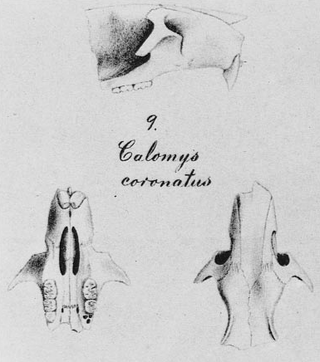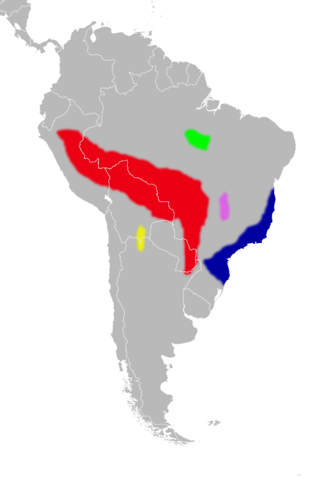
The acouchis are rodents belonging to the family Dasyproctidae from the Amazon basin. They are generally smaller than agoutis and have very short tails, while agoutis lack tails. For this reason the acouchis are also called tailed agoutis.

The oncilla, also known as the northern tiger cat, little spotted cat, and tigrillo, is a small spotted cat ranging from Central America to central Brazil. It is listed as Vulnerable on the IUCN Red List, and the population is threatened by deforestation and conversion of habitat to agricultural land.

The green acouchi is a species of rodent in the acouchi genus, part of the family Dasyproctidae. It is found in western Amazonia, west of the Rios Negro and Madeira, in northwestern Brazil, northeastern Peru, eastern Ecuador, southeastern Colombia, and southern Venezuela. There is substantial variation within this range, and the Green Acouchi, as currently recognized, may contain more than one species. Because the application of the scientific name acouchy, currently in use for the Red Acouchi, has historically been disputed, the name Myoprocta acouchy has sometimes been used for this species instead of Myoprocta pratti. The species is named for Antwerp Edgar Pratt who was a British naturalist.

The big red bat is a species of vesper bat from South and Central America.

Ferreira's spiny tree-rat is a spiny rat species found in Bolivia, Brazil, Colombia, Ecuador, French Guiana, Guyana, Peru, Suriname and Venezuela. The etymology of the species name corresponds to the Latin word hispidus meaning bristly.

The Guyenne spiny-rat or Cayenne spiny rat, is a spiny rat species found in Brazil, Colombia, French Guiana, Guyana, Suriname and Venezuela.
Cuvier's spiny-rat is a spiny rat species found in Brazil, French Guiana, Guyana, Peru and Suriname.

Euryoryzomys russatus, also known as the russet oryzomys, russet rice rat, or big-headed rice rat, is a species of rodent in the family Cricetidae. It is a member of the genus Euryoryzomys, which was split off from Oryzomys in 2006. It was first described by Johann Andreas Wagner in 1848. It is found in southern Brazil, eastern Paraguay and northeastern Argentina. It is considered a large species in its genus, with a reddish-brown coat, long tail length, and large skull. It is a terrestrial rodent, spending its time foraging for seeds, fruits, and insects. It is listed by the IUCN as least concern, although studies have shown it to be influenced by anthropogenic disturbances. Predators consist of small members of the order Carnivora.

Oligoryzomys longicaudatus, also known as the long-tailed colilargo or long-tailed pygmy rice rat, is a species of rodent in the genus Oligoryzomys of the family Cricetidae. It is found in the southern Andes of Chile and Argentina, with an outlying population in eastern Argentina. As a common species with a wide range and a stable population, the International Union for Conservation of Nature has rated this rodent as being of "least concern".

Alston's brown mouse, also called Alston's singing mouse, short-tailed singing mouse, or singing mouse, is a species of rodent in the family Cricetidae. It is found in Central America, from Chiapas, Mexico, to western Panama.

The green oropendola is a species of bird in the family Icteridae. It is found in wooded habitats in the Amazon basin and Guianas of South America, and is generally common. Uniquely among the oropendolas, the green oropendola has a pale bill with an orange tip. Male oropendola weigh around 400 grams, while females are in the 200 gram range. This is a common species and the International Union for Conservation of Nature has rated its status as being of "least concern".

The Mexican agouti,, also known as the Mexican black agouti, is a species of rodent in the genus Dasyprocta. This species was first discovered in 1860 in Veracruz, Mexico and described by Henri Louis Frédéric de Saussure.
The Brazilian spiny tree rat is a species of rodent in the family Echimyidae. It is found in Bolivia, Brazil, French Guiana, Guyana, Suriname and Venezuela, where it lives in lowland tropical rainforest. There is also a population in Ecuador which is referable either to this species or to Makalata macrurus. It is nocturnal, and eats seeds.
Tapirira bethanniana is a tall tree of the family Anacardiaceae. It is endemic to tropical rainforests of French Guiana.

The wing-barred seedeater is a passerine bird from coastal regions of north-eastern South America in north-eastern Venezuela, Tobago, the Guianas, Amapá and north-eastern Pará, Brazil, and along the Amazon River upstream to around Manaus. Formerly, it included the mainly Central American Sporophila corvina and the west Amazonian S. murallae as subspecies, in which case the combined species had the common name Variable Seedeater. Following the split, this common name is now restricted to S. corvina.

Euryoryzomys macconnelli, also known as MacConnell's rice rat or MacConnell's oryzomys, is a rodent species from South America. It is found in Brazil, Colombia, Ecuador, French Guiana, Guyana, Peru, Suriname and Venezuela, where it lives in lowland tropical rainforest. It was formerly placed in the genus Oryzomys, as Oryzomys macconnelli, but in 2006 it was reclassified as the type species of the new genus Euryoryzomys.

Guiana Amazonian Park is the largest national park of France, aiming at protecting part of the Amazonian forest located in French Guiana which covers 41% of the region. It is the largest park in France as well as the largest park in the European Union and one of the largest national parks in the world.

The Amazonian grosbeak or Rothschild's grosbeak is a species of grosbeak in the family Cardinalidae, the cardinals or cardinal grosbeaks. It is found in much of the Amazon Basin, in Bolivia, Brazil, Colombia, French Guiana, Guyana, Peru, Suriname, and Venezuela.

Theobroma speciosum is an arboriform species of flowering plant in the mallow family native to northern South America. It is the 35th most abundant species of tree in the Amazon rainforest.

















